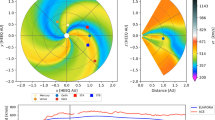Abstract
A prototype service for MHD modeling of the calm solar wind and forecasting the speed and density of solar wind particles in interplanetary space, similar to the NOAA and ESA services, has been created. The service consists of an MHD simulator, a module for processing simulation results, and a web interface. The simulator is based on the implementation of the TVDLF method in the PLUTO package. The boundary conditions of the model (density, radial velocity, magnetic field, temperature) at a distance of 0.1 AU from the origin are obtained regularly from the corresponding NOAA service, in which they are calculated according to the WSA model based on the magnetograms of the GONG network. Two modes of boundary conditions are available: constant and daily. The simulations were carried out on a uniform grid in the range of 0.1–1.7 AU by distance (512 elements), –60°...+60° by latitude (60 elements), 0°–360° by longitude (180 elements). The calculated particle velocity and density maps are compared with the NOAA SWPC and NASA CCMC calculations under the same boundary conditions. A retrospective comparison of the resulting forecasts with data from direct measurements (OMNI) was carried out.





Similar content being viewed by others
REFERENCES
Odstrcil, D., Modeling 3-D solar wind structure, Adv. Space Res., 2003, vol. 32, no. 4, pp. 497–506. https://doi.org/10.1016/S0273-1177(03)00332-6
Pomoell, J. and Poedts, S., EUHFORIA: European heliospheric forecasting information asset 2.0, J. Space Weather Space Clim., 2018, vol. 8, p. A35. https://doi.org/10.1051/swsc/2018020
Tlatov, A.G., Berezin, I.A., and Strelkov, M.A., Simulation of coronal mass ejection propagation based on data from ground-based patrol observations, Geomagn. Aeron. (Engl. Transl.), 2019, vol. 59, no. 7, pp. 843–845. https://doi.org/10.1134/S0016793219070247
Odstrcil, D., Mays, M.L., Hess, Ph., et al., Operational modeling of heliospheric space weather for the parker solar probe, Astrophys. J. Suppl. Ser., 2020, vol. 246, no. 2, p. 73. https://doi.org/10.3847/1538-4365/ab77cb
Tóth, G. and Odstrcil, D., Comparison of some flux corrected transport and total variation diminishing numerical schemes for hydrodynamic and magnetohydrodynamic problems, J. Comput. Phys., 1996, vol. 128, no. 1, pp. 82–100. https://doi.org/10.1006/jcph.1996.0197
Mignone, A., Bodo, G., Massaglia, S., et al., PLUTO: A numerical code for computational astrophysics, Astrophys. J. Suppl. Ser., 2007, vol. 170, no. 1, p. 228. https://doi.org/10.1086/513316
Arge, C.N. and Pizzo, V.J., Improvement in the prediction of solar wind conditions using near-real time solar magnetic field updates, J. Geophys. Res.: Space Phys., 2000, vol. 105, no. A5, pp. 10465–10479. https://doi.org/10.1029/1999JA000262
Pitjeva, E., Pavlov, D., Aksim, D., and Kan, M., Planetary and lunar ephemeris EPM2021 and its significance for Solar System research, Proc. Int. Astron. Union, 2019, vol. 15, no. S364, pp. 220–225. https://doi.org/10.1017/S1743921321001447
Berezin, I. and Tlatov, A., Coronal field geometry and solar wind speed, Universe, 2022, vol. 8, no. 12, p. 646. https://doi.org/10.3390/universe8120646
Aksim, D. and Pavlov, D., Improving the solar wind density model used in processing of spacecraft ranging observations, Mon. Not. R. Astron. Soc., 2022, vol. 514, no. 3, pp. 3191–3201. https://doi.org/10.1093/mnras/stac1229
ACKNOWLEDGMENTS
The authors are grateful to Dusan Odstrcil (George Mason University) for valuable advice. The authors are also grateful to Alexey Pecherkin and Natalya Strannikova (LETI) for their active participation at an early stage of the work. The authors are grateful to the CCMC team for the opportunity to conduct simulations (the simulation performed in the course of this work is available on the CCMC website under the title Aleksandr_Kodukov_101722_SH_1).
Funding
Research of Dmitry Pavlov was performed at the Saint-Petersburg Leonhard Euler International Mathematical Institute and supported by the Ministry of Science and Higher Education of the Russian Federation (agreement no. 075-15-2022-287).
Author information
Authors and Affiliations
Corresponding author
Ethics declarations
The authors declare that they have no conflicts of interest.
Rights and permissions
About this article
Cite this article
Arutyunyan, S., Kodukov, A., Subbotin, M. et al. A Prototype of a Background Solar Wind Forecasting Service Based on MHD Modeling and WSA Boundary Conditions. Cosmic Res 61, 457–463 (2023). https://doi.org/10.1134/S0010952523700508
Received:
Revised:
Accepted:
Published:
Issue Date:
DOI: https://doi.org/10.1134/S0010952523700508




